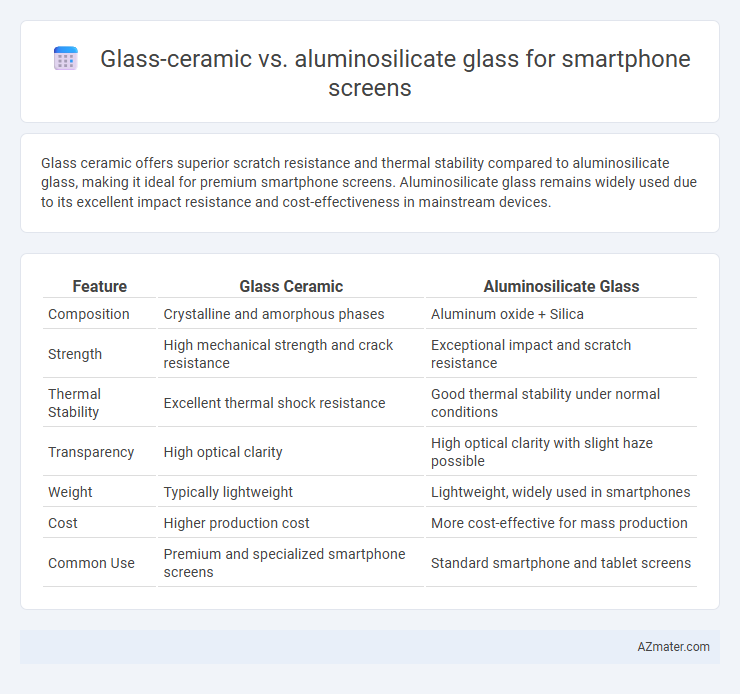Glass ceramic offers superior scratch resistance and thermal stability compared to aluminosilicate glass, making it ideal for premium smartphone screens. Aluminosilicate glass remains widely used due to its excellent impact resistance and cost-effectiveness in mainstream devices.
Table of Comparison
| Feature | Glass Ceramic | Aluminosilicate Glass |
|---|---|---|
| Composition | Crystalline and amorphous phases | Aluminum oxide + Silica |
| Strength | High mechanical strength and crack resistance | Exceptional impact and scratch resistance |
| Thermal Stability | Excellent thermal shock resistance | Good thermal stability under normal conditions |
| Transparency | High optical clarity | High optical clarity with slight haze possible |
| Weight | Typically lightweight | Lightweight, widely used in smartphones |
| Cost | Higher production cost | More cost-effective for mass production |
| Common Use | Premium and specialized smartphone screens | Standard smartphone and tablet screens |
Introduction: The Evolution of Smartphone Screen Materials
Glass ceramic offers enhanced durability and scratch resistance compared to aluminosilicate glass, making it a leading choice for next-generation smartphone screens. Aluminosilicate glass is widely known for its high strength and shatter resistance, commonly used in popular brands like Corning Gorilla Glass. The evolution from aluminosilicate to glass ceramic materials reflects the demand for improved toughness and longevity in smartphone displays.
What Is Glass Ceramic?
Glass ceramic is a material composed of fine-grained crystalline phases embedded within a glassy matrix, offering superior toughness and resistance to thermal shock compared to traditional glass. Unlike aluminosilicate glass, which is primarily an amorphous material enhanced through ion exchange for scratch resistance, glass ceramic features controlled crystallization that provides enhanced mechanical strength and durability for smartphone screens. Its unique microstructure results in higher impact resistance and improved optical clarity, making it a promising alternative for next-generation smartphone displays.
What Is Aluminosilicate Glass?
Aluminosilicate glass is a specialty glass composed primarily of aluminum oxide and silicon dioxide, designed for enhanced durability and resistance to thermal shock. It offers superior hardness and scratch resistance compared to conventional glass, making it ideal for smartphone screens that demand high scratch and impact protection. This type of glass provides improved mechanical strength and chemical stability, contributing to longer-lasting smartphone displays.
Key Material Properties: Hardness and Durability
Glass ceramic offers superior hardness and durability compared to aluminosilicate glass, making it highly resistant to scratches and impact damage in smartphone screens. Aluminosilicate glass, commonly used in devices like Gorilla Glass, provides excellent toughness and flexibility but is more prone to surface scratches and micro-cracks under extreme stress. The unique crystalline structure of glass ceramics enhances their mechanical strength and thermal stability, resulting in longer-lasting screen protection for smartphones.
Impact Resistance: Which Glass Survives Daily Drops?
Glass ceramic offers superior impact resistance compared to aluminosilicate glass, thanks to its crystalline structure that absorbs and dissipates shock more effectively. Aluminosilicate glass, commonly used in smartphone screens like Gorilla Glass, provides good scratch resistance but is more prone to shattering upon significant drops. Studies show that glass ceramic screens can endure higher impact forces, making them more durable for daily accidental drops in smartphones.
Scratch Resistance: Protecting Your Screen from Everyday Hazards
Glass ceramic offers superior scratch resistance compared to aluminosilicate glass due to its crystalline structure that enhances hardness and durability. Aluminosilicate glass, used in popular smartphone screens like Gorilla Glass, provides good scratch resistance but is more prone to micro-abrasions over time. Choosing glass ceramic can significantly reduce visible scratches and maintain screen clarity, enhancing long-term device protection from everyday hazards like keys and coins.
Clarity and Touch Sensitivity: Visual and User Experience
Glass ceramic offers superior clarity due to its low refractive index and minimal light scattering, resulting in sharper and more vibrant displays on smartphones. Aluminosilicate glass excels in touch sensitivity because of its high ion-exchange strength and smooth surface, enhancing responsiveness and accuracy in user interactions. Combining these materials is often explored to optimize visual quality while maintaining precise touch performance in advanced smartphone screens.
Cost Considerations: Price vs. Performance
Glass ceramic offers enhanced scratch resistance and higher thermal stability compared to aluminosilicate glass, but it comes at a significantly higher manufacturing cost, impacting overall smartphone pricing. Aluminosilicate glass provides a cost-effective balance with strong durability and adequate impact resistance, making it the preferred choice for mainstream smartphone screens. The price-performance ratio favors aluminosilicate glass for budget and mid-range devices, while glass ceramic is often reserved for premium models requiring superior longevity and resilience.
Real-World Applications: Which Brands Use Which Glass?
Glass ceramic and aluminosilicate glass differ significantly in smartphone screen applications, with aluminosilicate glass such as Corning Gorilla Glass widely used by brands like Apple, Samsung, and Google for its exceptional scratch resistance and impact durability. Glass ceramic, though less common, is favored in niche devices requiring enhanced thermal stability and crack resistance, seen in products from some premium brands like Sony. Real-world usage highlights aluminosilicate glass's dominance in mainstream smartphones due to its balance of toughness and cost-effectiveness, while glass ceramic remains specialized for high-end or rugged models.
Conclusion: Choosing the Best Glass for Your Smartphone
Aluminosilicate glass offers superior scratch resistance and durability, making it ideal for everyday smartphone use, while glass ceramic provides enhanced thermal stability and crack resistance, beneficial for extreme conditions. Considering typical user scenarios, aluminosilicate glass is generally preferred for its balance of toughness and cost-effectiveness in most smartphones. Selecting the best glass depends on usage patterns, with aluminosilicate glass excelling in impact resistance and glass ceramic standing out for high-temperature resilience.

Infographic: Glass ceramic vs Aluminosilicate glass for Smartphone screen
 azmater.com
azmater.com